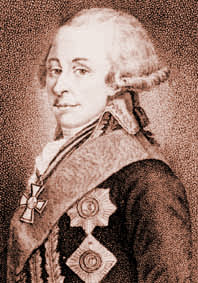
Catherine II, most commonly known as Catherine the Great, was the reigning empress of Russia from 1762 to 1796. She came to power after overthrowing her husband, Peter III. Under her long reign, inspired by the ideas of the Enlightenment, Russia experienced a renaissance of culture and sciences, which led to the founding of many new cities, universities, and theatres, along with large-scale immigration from the rest of Europe and the recognition of Russia as one of the great powers of Europe.
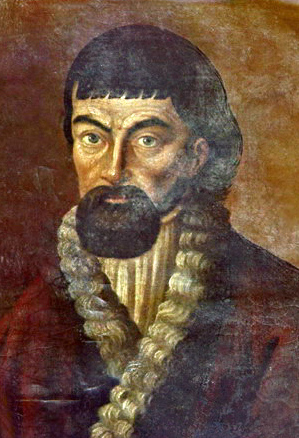
Yemelyan Ivanovich Pugachev was an ataman of the Yaik Cossacks and the leader of the Pugachev's Rebellion, a major popular uprising in the Russian Empire during the reign of Catherine the Great.

Prince Grigory Aleksandrovich Potemkin-Tauricheski was a Russian military leader, statesman, nobleman, and favourite of Catherine the Great. He died during negotiations over the Treaty of Jassy, which ended a war with the Ottoman Empire that he had overseen.

The Kingdom of Kartli-Kakheti was created in 1762 by the unification of the two eastern Georgian kingdoms of Kartli and Kakheti. From the early 16th century, according to the 1555 Peace of Amasya, these two kingdoms were under Iranian control. In 1744, Nader Shah granted the kingship of Kartli to Teimuraz II and that of Kakheti to his son Heraclius II, as a reward for their loyalty. When Nader Shah died in 1747, Teimuraz II and Heraclius II capitalized on the instability in Iran proper, and declared de facto independence. After Teimuraz II died in 1762, Heraclius succeeded him as ruler of Kartli, thus unifying the two kingdoms.

Heraclius II, also known as Erekle II and The Little Kakhetian, of the Bagrationi dynasty, was the king (mepe) of the Kingdom of Kakheti from 1744 to 1762, and of the Kingdom of Kartli-Kakheti from 1762 until his death in 1798. In the contemporary Persian sources he is referred to as Erekli Khan, while Russians knew him as Irakly (Ираклий). Heraclius is the Latinized form of his name.

Pugachev's Rebellion of 1773–1775 was the principal revolt in a series of popular rebellions that took place in the Russian Empire after Catherine II seized power in 1762. It began as an organized insurrection of Yaik Cossacks headed by Yemelyan Pugachev, a disaffected ex-lieutenant of the Imperial Russian Army, against a background of profound peasant unrest and war with the Ottoman Empire. After initial success, Pugachev assumed leadership of an alternative government in the name of the late Tsar Peter III and proclaimed an end to serfdom. This organized leadership presented a challenge to the imperial administration of Catherine II.
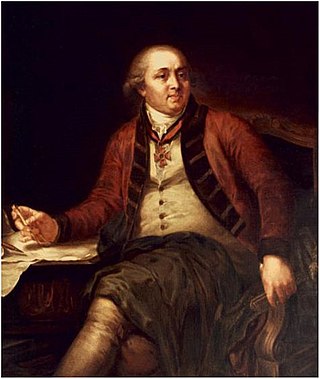
Ivan Yegorovich Starov was a Russian architect from St. Petersburg who devised the master plans for Yaroslavl, Voronezh, Pskov, Dnipro, Mykolaiv, and many other towns in Russia and Ukraine. His radial urban master plan for Yaroslavl (1778), cleverly highlighting dozens historic churches and towers, is recognized as one of the World Heritage Sites.

Count Alexander Nikolayevich Samoylov was a Russian general and statesman. He distinguished himself in the Russo-Turkish War of 1787–1792 and was Prosecutor General of the Russian Empire.

Nikolai Petrovich Arkharov was a Russian chief of police best known for having given his name to the Russian term "arkharovtsy", an ironic appellation of policemen.

Aleksandr Ilyich Bibikov was a Russian statesman and military officer.
Astafy Trifonovich Dolgopolov, was a Russian confidence trickster and impostor deceiving both Yemelyan Pugachev and Catherine II of Russia during the Pugachev Rebellion.

The House of Engelhardt is a Baltic-German noble and baronial family of the former Russian Empire. The family name is sometimes given as von Engelhardt.
Fatali Khan or Fath Ali Khan of Quba was a khan of the Quba Khanate (1758–1789) who also managed to dominate the Derbent, Baku, Talysh and Shirvan Khanates, as well as the Salyan Sultanate during much of his reign.
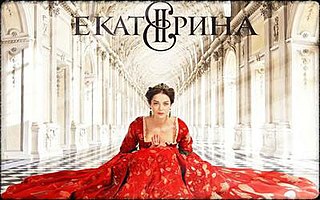
Ekaterina is a 2014 Russia-1 historical television series starring Marina Aleksandrova as the eventual Russian empress Catherine the Great. The first season tells the story of princess Sophie Friederike Auguste, and her rise to power to become Empress of Russia, following a coup d'état and the assassination of her husband, Peter III. The second season portrays the challenges she faces at home and abroad during the early years of her rule, as she tries to revitalise Russia to become one of the great powers of Europe, and becomes titled "the Great".

Mirian was a Georgian prince (batonishvili) of the Bagrationi dynasty, born to King Heraclius II and Queen Darejan Dadiani. After Heraclius placed his kingdom under the Russian protectorate in 1783, Mirian entered the Russian army, attaining to the rank of major general. He reconciled with the Russian annexation of Georgia in 1801, departing to St. Petersburg, where he ended his days as a senator of the Empire. Of some literary talent, Mirian translated from Russian and himself composed poetry.

Johann von Michelsohnen was a Baltic German military commander who served in the Imperial Russian Army. He was a prominent general in several wars, but his most noted contribution was his critical role in suppressing Pugachev's Rebellion.

Sergey Lazarevich Lashkarev, was a Russian Imperial Major-General of Georgian origin. A cunning diplomat and polyglot, he was described by his contemporaries as one of the "remarkable phenomena of Catherine the Great's century". Lashkarev was reportedly fluent in ten languages. Besides Russian and Georgian, he spoke French, Italian, Turkish, Persian, Greek, Armenian, Arabic, and Latin. In 1800, Lashkarev was actively involved in diplomatic exchanges with the Ottoman Empire in connection with the impending Russian annexation of various Georgian kingdoms and principalities, and remained in charge of Georgian affairs at the Imperial court under Alexander I of Russia.
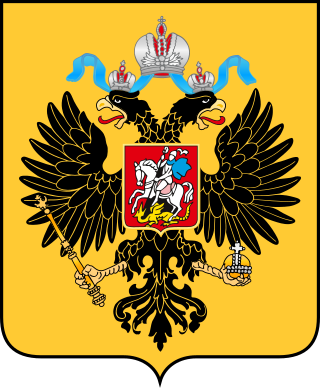
The Council at the Highest Court was the highest advisory institution in the Russian Empire that existed from 1768 to 1801.

Count Pavel Sergeyevich Stroganov was an art collector, philanthropist, and cup-bearer at the Imperial Court.

Hovsep Arghutian, known in Russian as Iosif Argutinsky-Dolgorukov, was an eighteenth-century Armenian archbishop who served as the religious leader of Armenians in the Russian Empire. He played a key role in the establishment of Armenian settlements in Russia, most notably that of Nakhichevan-on-Don. He co-founded the first Armenian press in Russia and directed its activities. He had a close personal relationship with Catherine the Great and Grigory Potemkin and advised them on Russia's policies in the Caucasus region. Arghutian was a committed Russophile and sought Russian support for the creation of an Armenian state. He personally participated in the Russian campaign against Persia in 1796. He was elected Catholicos of All Armenians in 1800, but died on his way to Ejmiatsin in 1801 and was never consecrated.
